|
|
|
Sort Order |
|
|
|
Items / Page
|
|
|
|
|
|
|
| Srl | Item |
| 1 |
ID:
130269
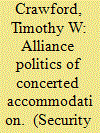

|
|
|
|
|
| Publication |
2014.
|
| Summary/Abstract |
This article examines the challenges allies face in coordinating diplomatic efforts to accommodate and peel off their main enemy's Potential Allies. It elucidates the key dimensions, and the underlying Coordination Dynamics, of this problem of "concerted accommodation," and it develops propositions about the conditions that shape the efficacy of such efforts. The argument links allies' strength to their divergent or convergent assessments of the target state's ability to tip the war toward victory or defeat. Divergent assessments foster weak allied efforts that are likely to fail, but when allies agree that the target is a potential "war-tipper," they will support their concerted accommodation policy with more robust cooperation that is more likely to work. The causal arguments and mechanisms are examined in a paired comparison analysis of two First World War cases: the Entente's efforts to induce (1) Ottoman neutrality and (2) Italian intervention.
|
|
|
|
|
|
|
|
|
|
|
|
|
|
|
|
| 2 |
ID:
181390
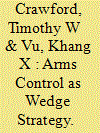

|
|
|
|
|
| Summary/Abstract |
Strategic arms control is in crisis. The United States and Russia have retreated from agreements that formed the framework for post–Cold War arms cuts and strategic stability, such as the Anti-Ballistic Missile Treaty, the Treaty on Conventional Armed Forces in Europe, and the Intermediate-Range Nuclear Forces Treaty. The only strategic arms control agreement between the United States and Russia (i.e., New START) expires in 2026. The political forcefield that sustained the old framework has been altered by major technological revolutions and China's rise. Motives for strategic arms control are conventionally framed in terms of their potential to enhance stability by limiting certain weapons, avoiding costly arms races, or preserving military advantage. But states can also use strategic arms control to divide adversaries. Wedge strategy theory explains how arms control can do so by affecting adversaries' threat perceptions, their beliefs about the costs and benefits of formal commitments, and their degree of trust in one another. Three landmark strategic arms control negotiations (the Five-Power Treaty and the Four-Power Treaty at the Washington Naval Conference, the Limited Nuclear Test Ban Treaty, and the Strategic Arms Limitation Talks) show how the wedge motive informed these negotiations and influenced great power relations. The wedge logic remains relevant today. For example, the United States may employ future arms control agreements to drive a wedge between China and Russia, and it must be cautious about arms control deals with North Korea that would negatively affect its relationship with South Korea.
|
|
|
|
|
|
|
|
|
|
|
|
|
|
|
|
| 3 |
ID:
181348
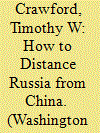

|
|
|
|
|
| Summary/Abstract |
Military alignment between Russia and China is increasing.1 Although some still downplay its significance, alarm is warranted.2 Many perceive the dangerous trend but conclude that the United States can do little to detach Moscow from Beijing.3 Still, there are serious calls for the United States to find ways to improve relations with Moscow and draw it away from China.4 These are, in essence, calls for the United States to use a wedge strategy—a policy to move or keep a potential adversary out of an opposing alliance.5 Yet, when it comes to how to do that, debate is constricted by the usual grooves of foreign policy orthodoxy and flawed answers to two basic questions: first, what is the mainspring of Russia-China convergence? Misdiagnosis here makes it harder to discern potential remedies and easier to prescribe ones that make matters worse. Second, what is the essential danger that their convergence poses? Confusion here makes it harder to gauge whether this can and should be changed at an acceptable cost.
|
|
|
|
|
|
|
|
|
|
|
|
|
|
|
|
| 4 |
ID:
022621
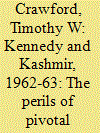

|
|
|
|
|
| Publication |
2002.
|
| Description |
1-38
|
| Summary/Abstract |
This article examines the Kennedy administration's strategy for making peace between India and Pakistan in 1963. It was assumed that India and Pakistan's mutual need for US support would lead them to curry US favor by showing flexibility on Kashmir. However, the US vied with the USSR as a patron to India, and with China as an ally to Pakistan. As a hedge against weak US promises to defend Pakistan against Indian attack, Pakistan cultivated a tacit alliance with China, while for India, Moscow became an enthusiastic alternative source of military supplies. This forced the United States to reduce the political conditions it attached to its military patronage and diplomatic support, which helps to explain why the US effort to broker peace in Kashmir failed in 1963. It also suggests important obstacles to the United States doing so today.
|
|
|
|
|
|
|
|
|
|
|
|
|
|
|
|
| 5 |
ID:
103656
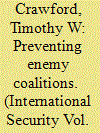

|
|
|
|
|
| Publication |
2011.
|
| Summary/Abstract |
States use wedge strategies to prevent hostile alliances from forming or to disperse those that have formed. These strategies can cause power alignments that are otherwise unlikely to occur, and thus have significant consequences for international politics. How do such strategies work and what conditions promote their success? The wedge strategies that are likely to have significant effects use selective accommodation-concessions, compensations, and other inducements-to detach and neutralize potential adversaries. These kinds of strategies play important roles in the statecraft of both defensive and offensive powers. Defenders use selective accommodation to balance against a primary threat by neutralizing lesser ones that might ally with it. Expansionists use selective accommodation to prevent or break up blocking coalitions, which isolates opposing states by inducing potential balancers to buck-pass, bandwagon, or hide. Two cases-Great Britain's defensive attempts to accommodate Italy in the late 1930s and Germany's offensive efforts to accommodate the Soviet Union in 1939-help to demonstrate these arguments. By paying attention to these dynamics, international relations scholars can better understand how balancing works in specific cases, how it manifests more broadly in international politics, and why it sometimes fails in situations where it ought to work well.
|
|
|
|
|
|
|
|
|
|
|
|
|
|
|
|
| 6 |
ID:
081247
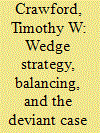

|
|
|
|
|
| Publication |
2008.
|
| Summary/Abstract |
Wedge strategies seek to divide alliances or to prevent them from forming. Despite their importance in balance of power politics, they have not received systematic attention in security studies. This article corrects that problem. First, it develops a concept of wedge strategy that connects it to balancing behavior and shows how the phenomenon can help to explain "alignment anomalies" in international politics. Second, it mounts an intensive study of the deviant case of Spanish alignment in 1940-41, demonstrating that a British wedge strategy was a necessary and proximate cause of that alignment anomaly, which was an outcome of great consequences for the conduct and conclusion of the Second World War. It concludes by returning to basic conceptual issues, discussing the implications of thinking theoretically about wedge strategies for two facets of international security: the relationship between appeasement and balancing and the power politics of neutrality
|
|
|
|
|
|
|
|
|
|
|
|
|
|
|
|
|
|
|
|
|